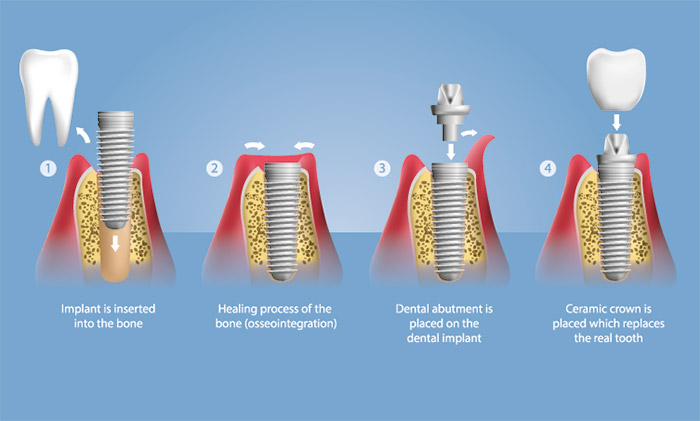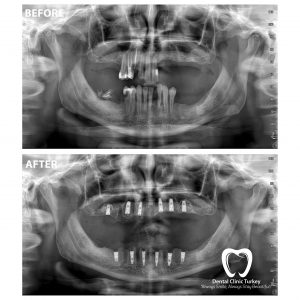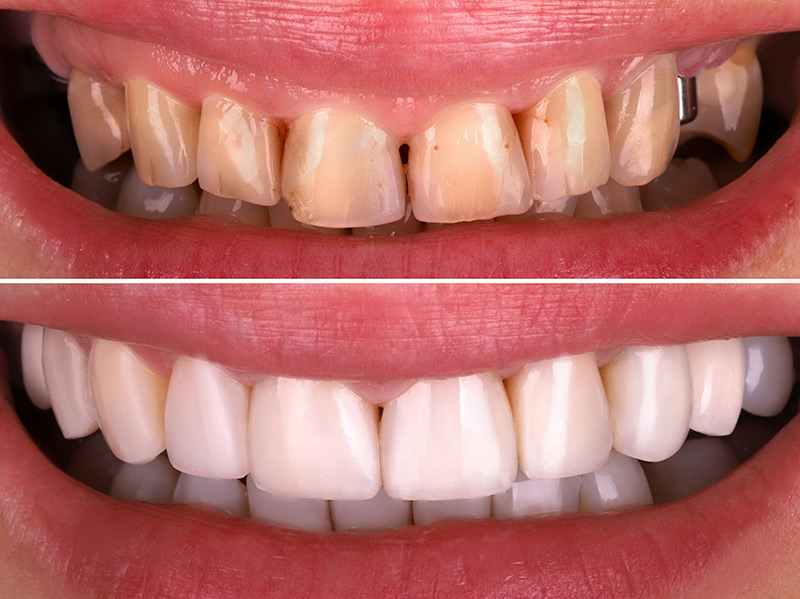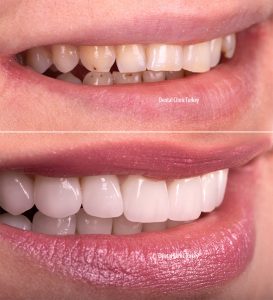Implant After Tooth Extraction
The priority of people who have to have a tooth extraction in the near future is to eliminate this missing tooth as soon as possible. Having a missing tooth in the mouth not only creates a noticeable gap during smiling, but can also cause deterioration in chewing function. Today, although there are different dental procedures that can be applied to eliminate tooth deficiencies in the mouths of patients, dental implants are considered to be the longest-lasting solution that provides the most natural results. Dental implant application helps to achieve an appearance and natural tooth feeling as if the natural tooth has not been lost. At this point, it is important to note how long it takes to have an implant after tooth extraction.
What Happens After Tooth Extraction?
After tooth extraction, an unnatural feeling of emptiness occurs in the area. In addition, tooth loss can lead to some changes that will take time to notice. Since there is no stimulation from the tooth roots with the extraction of the tooth, deterioration of the lower jawbone begins. Loss of the jawbone may create less support for the other teeth in the area, leading to the need for these teeth to be extracted over time.
In addition, slippage is seen in the teeth on both sides of the extracted tooth. This not only causes aesthetic concerns. It may also impair your ability to chew properly. Severe misalignment of the bite can result in problems such as temporomandibular joint disorder or chronic teeth grinding.
How Long Does It Take for Tooth Extraction to Heal?
Tooth extraction procedure may vary according to the condition of the tooth, the general health of the patient and similar factors. After tooth extraction, some of the most common symptoms are swelling and bleeding in the affected area. After tooth extraction, patients usually recover within 7 to 10 days.
The choice of diet after tooth extraction has a great impact on the rapid recovery of the patient. Particular attention should be paid to diet, both in the early postoperative period and in the days following the operation, in order to avoid unforeseen problems and to guarantee a speedy recovery.
What to Eat After Tooth Extraction?
Only liquid and soft foods should be consumed for the first 24 hours after tooth extraction. Foods such as yogurt, pudding, soup, applesauce, ice cream can be consumed in this process. During this time, it is important to avoid swirling liquids in the mouth as this can cause dislodgement of clots formed after tooth extraction.
48 hours after tooth extraction, as the patient starts to feel better, he or she can start to consume a wider variety of foods. Try solid foods that are easy to chew, such as eggs, oatmeal, and soft toast.
More different foods can be included in the nutrition program 3 days after tooth extraction. Consumption of mashed potatoes, cottage cheese, well-boiled pasta, zucchini, seedless ripe and soft fruits can be preferred. Even if soft foods are consumed, it should not be neglected that the portions are made into small positions that are easy to chew. At this stage, the mouth can be gently rinsed with a combination of warm water and salt to destroy the bacteria in the mouth.
Harder foods can be reintroduced into the diet 1 week after tooth extraction. However, care should be taken to see if any problems such as gingival bleeding occur.
When Can Implants Be Made After Tooth Extraction?
The time required to wait for implant placement after tooth extraction may vary depending on several factors such as the patient’s general health, whether there is an infection around the extracted tooth, and the health of the surrounding tissue and bone.
If the patient has healthy gums and sufficient jawbone density, implant placement may be possible immediately after the tooth extraction procedure. Generally, in cases where tooth loss is due to trauma or injury, a titanium implant is placed in the bone and the osseointegration process is expected to be completed in 3 to 6 months. At the end of this period, when the implant integrates with the jawbone in the area, a permanent crown is attached.
This method, applied immediately after tooth extraction, is advantageous in helping to prevent possible bone loss.
The method called early implant is performed 2 to 3 months after tooth extraction. This need for delay is often caused by damaged gums and supporting tissue, or by an infection that needs to heal before implant placement. If there is an oral infection, it should also be cleaned before the implant is placed. Since it is not necessary to wait for a very long time after tooth extraction, the procedure can often be completed without significant deterioration in the jawbone and before bone grafting becomes necessary.
In patients who have had tooth decay for a while, it is possible that the gums and tissues are badly affected by this condition, as well as bone loss. If tooth extraction was performed as a result of such a problem, a bone graft procedure may be needed to provide adequate bone stability for the implant. This procedure can be applied 4 to 6 months after tooth extraction.
Although the waiting times may vary for the patient, dental implants have many advantages. Designed to last a lifetime, dental implants mimic the natural tooth root. Thus, it eliminates the risk of bone loss in the area by stimulating the jawbone. Since an aesthetically pleasing smile is obtained, the patient does not experience problems caused by missing teeth while speaking, laughing or taking pictures.
After the dental implant is made, it can have the same feeling and appearance as natural teeth, and a comfortable use can be achieved.
Get Free Quote
If you ask what should be done for a smile, your doctor should first check your mouth and tooth structure. He will then offer you tailored treatments and answer your question. To get information about beautiful smile, you can call us, fill out our consutlation form or send a message directly via Whatsapp.



 Dental Veneers; It is a dental treatment applied to the front side of teeth to eliminate problems such as enamel wear, irregular alignment or gap between teeth, tooth discoloration or tooth decay. dental cracks.
Dental Veneers; It is a dental treatment applied to the front side of teeth to eliminate problems such as enamel wear, irregular alignment or gap between teeth, tooth discoloration or tooth decay. dental cracks. One of the most important things to consider in order to extend the life of dental crowns is to avoid clenching your teeth. Squeezing can lead to wear and cracking of tooth coatings. For this reason, people who have teeth grinding problems (bruxism), these people should not neglect to use a gutter, especially during sleep, to protect their dental crowns. The aligner manages to protect not only the dental crowns but also the natural teeth of the individual’s mouth from excessive clenching force of the teeth.
One of the most important things to consider in order to extend the life of dental crowns is to avoid clenching your teeth. Squeezing can lead to wear and cracking of tooth coatings. For this reason, people who have teeth grinding problems (bruxism), these people should not neglect to use a gutter, especially during sleep, to protect their dental crowns. The aligner manages to protect not only the dental crowns but also the natural teeth of the individual’s mouth from excessive clenching force of the teeth.
 The quality of the bone is also one of the factors affecting the success of the implant. In addition, before the treatment and as long as the implant remains in the mouth, the gums must be completely healthy.
The quality of the bone is also one of the factors affecting the success of the implant. In addition, before the treatment and as long as the implant remains in the mouth, the gums must be completely healthy. As you get older, tooth loss increases due to reasons such as decay and gum problems. As increasing tooth loss makes it difficult to eat and drink, it has a very negative effect on the life comfort of elderly individuals. Nutritional problems that occur with or without chronic diseases are also the trigger of different health problems.
As you get older, tooth loss increases due to reasons such as decay and gum problems. As increasing tooth loss makes it difficult to eat and drink, it has a very negative effect on the life comfort of elderly individuals. Nutritional problems that occur with or without chronic diseases are also the trigger of different health problems.

 The aesthetic dental smile we call Hollywood Smile can be applied to almost every person (over 18 years old). Only the way of application can change. In some people, the application can be made with no or very little shaving of the tooth. This application can generally be laminated (veneers). For people who cannot be laminated, crown application can be preferred. These are E-max Crowns, zirconium, metal supported coating etc.
The aesthetic dental smile we call Hollywood Smile can be applied to almost every person (over 18 years old). Only the way of application can change. In some people, the application can be made with no or very little shaving of the tooth. This application can generally be laminated (veneers). For people who cannot be laminated, crown application can be preferred. These are E-max Crowns, zirconium, metal supported coating etc.
 Laminate veneers are aesthetic restorations that are applied in enamel defects, tooth discoloration, diestema (the presence of gaps between the teeth), bent and worn teeth, and especially in young patients with large pulp sizes, as an alternative to
Laminate veneers are aesthetic restorations that are applied in enamel defects, tooth discoloration, diestema (the presence of gaps between the teeth), bent and worn teeth, and especially in young patients with large pulp sizes, as an alternative to 
 What to do for a beautiful smile? Orthodontic treatment can be applied at any age. It depends on the extent of the dental problem but is usually a long-term treatment. It is based on the installation of a special device for repositioning the tooth.
What to do for a beautiful smile? Orthodontic treatment can be applied at any age. It depends on the extent of the dental problem but is usually a long-term treatment. It is based on the installation of a special device for repositioning the tooth.

 The molars are the teeth at the back of the teeth that help break down food. The risk of breaking molars is lower than anterior teeth, but there is still a possibility of fracture. A broken molar can cause toothache, bleeding in the gingival membrane, and infection. The treatment of broken molars is treated after the examination by the dentist.
The molars are the teeth at the back of the teeth that help break down food. The risk of breaking molars is lower than anterior teeth, but there is still a possibility of fracture. A broken molar can cause toothache, bleeding in the gingival membrane, and infection. The treatment of broken molars is treated after the examination by the dentist.